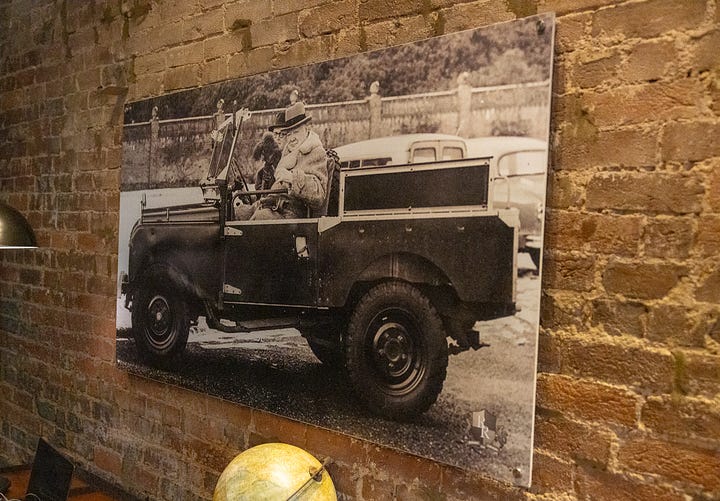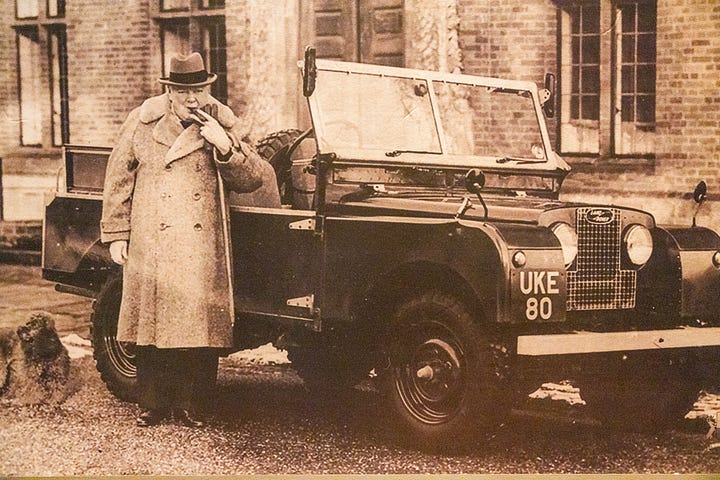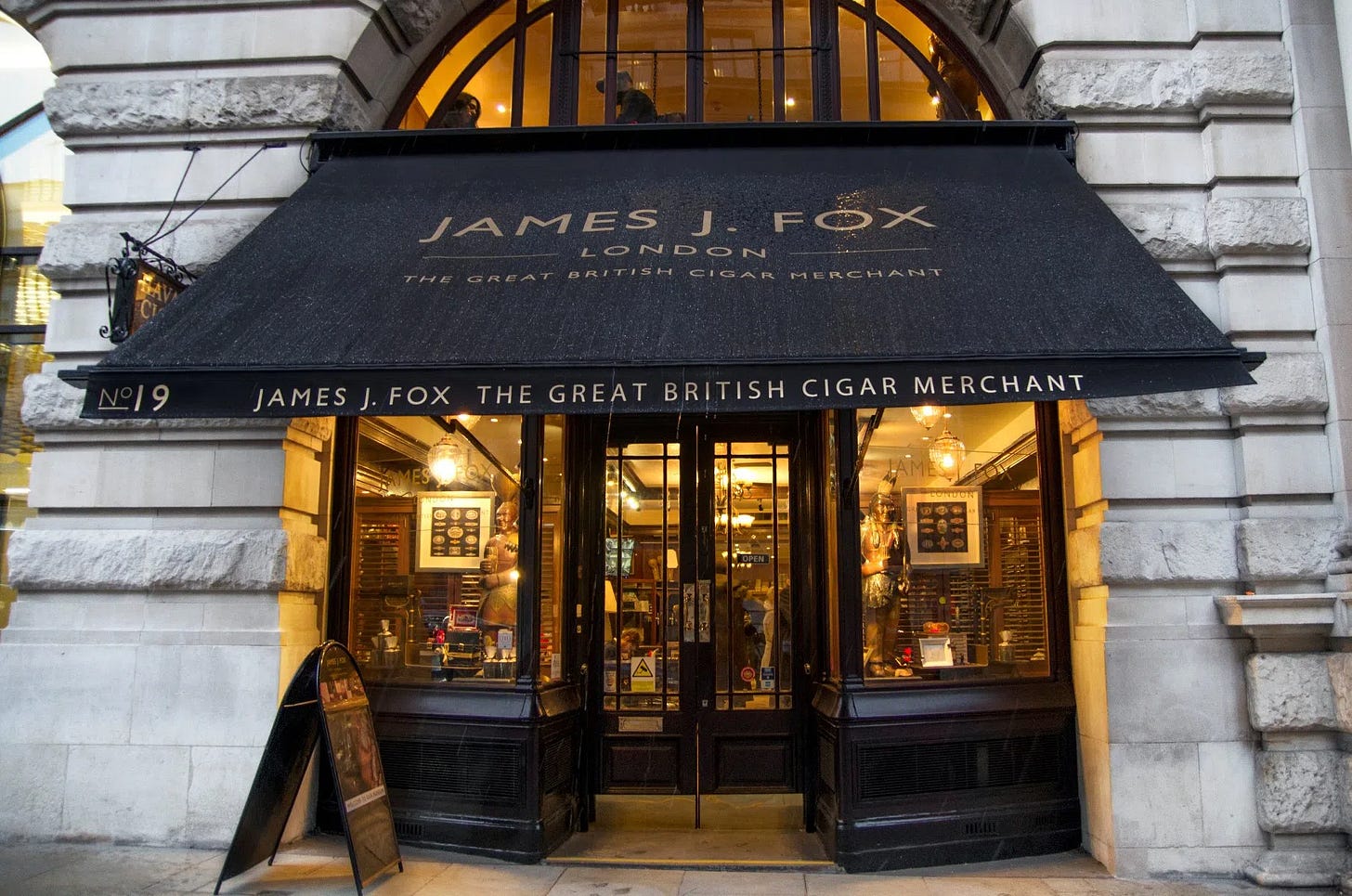The Old Swede: August 7th, 2025
The World Beyond the Gunroom: A dispatch from the realms of motors, manners, memory, and myth beyond the sporting field.
Off-Road Well
The Land Rover Series I of Winston Churchill
It wasn’t fast, elegant, or comfortable—but it was a vehicle that helped win the peace. In the postwar years, Winston Churchill—never one to shy away from a symbol—became synonymous with the Land Rover Series I. He was famously gifted one in 1954 for his 80th birthday by the Rover Company. Registered UKE 80, the vehicle was used at Chartwell, his country estate in Kent, where Churchill would be seen puttering across the grounds with his cigar in mouth, inspecting livestock, and surveying the trout lakes.
Painted in RAF blue-grey with a canvas top and benches in the rear, Churchill’s Land Rover came with a personalized brass plaque mounted to the dash: “Presented to the Right Honourable Sir Winston S. Churchill KG, OM, CH, MP.”
The Series I was built for rough use—aluminum body, 4WD, and leaf spring suspension. That it ended up in Churchill’s hands was fitting: both the man and the machine were rugged, unpolished, and utterly unkillable.
Today, the original Land Rover remains preserved, often displayed at Chartwell and occasionally driven during commemorative events. A symbol of legacy, terrain, and unfiltered character.


London Best
JJ Fox Cigars — 19 St. James’s and the Smoke of Empire
Step into James J. Fox Cigars, and you step into 200 years of smoke, diplomacy, and tradition. Located at 19 St. James’s Street, just a few paces from Berry Bros. & Rudd and Lock & Co., Fox’s is the oldest cigar merchant in the world still in operation. The shop is a temple of calm—its mahogany cabinets, soft lighting, and cedar humidors barely changed since the 1850s.
Winston Churchill was a regular customer. His personal cigar purchases are still on display in their museum archive, alongside a leather chair he used during private visits. He preferred Romeo y Julieta cigars, most often the large, commanding size that would later bear his name: the Churchill.
Fox’s serves royalty, statesmen, and connoisseurs alike. Their in-house experts guide customers through Cuban and Nicaraguan blends with the reverence of sommeliers. Upstairs is a cigar lounge, replete with leather armchairs, whisky service, and the scent of gentlemen plotting across centuries.
The Churchill connection remains vital to the Fox legacy—and to the mythos of St. James’s. Here, you don’t buy a cigar. You inherit a ritual.
Suggested Read:
Churchill and Cigars — David Lloyd George, Fox Archive
Art & Ephemera
Churchill’s Favorite Cigar — The Birth of the ‘Churchill’ Vitola
Few items of personal habit became so entwined with a public identity as Churchill’s cigars. Throughout his adult life, from Sandhurst to Yalta, he was rarely seen without one in hand, most often a Romeo y Julieta, size 7 inches by 47 ring gauge, eventually renamed the “Churchill.”
He smoked anywhere from 8 to 10 cigars a day, sometimes more during long days in the War Rooms. While he occasionally dabbled in other brands—La Aroma de Cuba, Partagás—it was Romeo y Julieta he adored for its boldness, smooth draw, and regal shape.
The “Churchill” size became a formal vitola after his death. A blend of power and elegance, it commands time and patience. Today, manufacturers around the world continue to craft cigars in this format in his honor—robust yet refined, much like the man himself.
The FDR-Churchill correspondence includes notes on shared cigars. One 1942 letter references a shipment of “fat Cuban ladies” en route from London to Hyde Park. His cigar box from that era remains in the Imperial War Museum, engraved in silver and fitted with a humidified cedar lining.
Imperial War Museum Archive – Churchill Room
Suggested Read:
Churchill Style — Barry Singer
Gamekeeper Journal Entry
“The Snipe and the Silence” — October 1936, Woodcock Rise, Norfolk
"First snipe seen in the far marsh. Wind soft from the west. Moss flushed a hen bird on the second pass but held steady. Lord H. arriving tomorrow with Lady E. — beaters to assemble at first light. The marsh line must be re-flagged. Signs of stoat along ditch corner."
This excerpt from Arthur Kelling’s 1936 journal, head keeper of Woodcock Rise, reflects the clipped precision of the profession. Each day, each page, captured weather, game movement, dog work, and seasonal tensions as if no one would ever read them—and yet every word is poetry in the raw.
The October entry reflects the start of snipe and woodcock passage through the estate’s fenland. Kelling, known for his disdain of slack dogs and his love of river trout, kept obsessive records. When guests came—especially aristocrats—his tone shifted, not in deference but in duty.
The entry also includes hand-drawn diagrams—beat lines, dog casting patterns, and pond levels, preserved today in the Norfolk County Gamekeeping Archive. Kelling’s journals give us not just a glimpse of the marsh, but the weight of every morning bootprint in frost.
Norfolk Gamekeeping Archive, Box 14: Kelling Ledger
Suggested Read:
The Keeper’s Year — Tom Quinn
British Campaign Lore
The Safari Gun Rack — Collapsible, Walnut and Leather, and Ready for the Rift
One of the unsung heroes of the old safari camp was not the tracker, the cook, or even the gun, it was the gun rack itself. Designed to collapse flat for transit and open swiftly for access, these racks carried double rifles, Mauser 98s, and Mannlichers with the reverence of a regimental armoury.
Early 20th-century British safari outfitters such as Manton & Co., Holland & Holland, and John Rigby built racks in brass, teak, and walnut, often with felt lining and compartments for cartridges, oilers, cleaning rods, and labels for each hunter’s battery. A good rack had balance—it stood up to dust, rain, and rhino charge.
Photographs of Roosevelt’s 1909 safari show a four-place rack mounted beside his tent. Denys Finch Hatton’s rig, by contrast, was built into his camp chest. In Hemingway’s Green Hills of Africa, a “rack of rifles like silver spines” stands just outside the dining fly.
For collectors today, original safari racks are rarer than the guns they once held, and often just as beautiful. Most remain in the field lodges of Kenya and Namibia, untouched since independence.
Suggested Reads:
The Tent and the Rifle — Julian Huxley
Shooting Estate or Club Invitation
Chartwell and the Pheasant Drives of Churchill’s Youth
Before the speeches, the cigars, and the bulldog mythos, Winston Churchill was simply a young man who loved to shoot. At Chartwell, his country estate in Kent, he arranged modest pheasant days with friends, cabinet colleagues, and military officers. The ground was modest, but the company legendary.
Churchill’s shooting diaries from the 1920s reveal a sportsman both eager and inconsistent. He once famously missed seven birds in a row, then hit a right-and-left on high partridge and shouted, “Back in the game!” His favorite gun? A 12-bore side-by-side by Stephen Grant, built in the 1890s, now on display at Chartwell.
The estate still runs seasonal shoot days for conservation and heritage events, though no live shooting occurs today. The old beat lines, stone shooting butts, and converted barn lodges remain. The drawing room, where maps were laid and claret poured, overlooks the field still known as “Winston’s Peg.”
A day here is not about sport, but about memory. To walk where Churchill once missed and laughed is a sporting honor in its own right.
Suggested Reads:
Churchill: The Wilderness Years — Martin Gilbert





